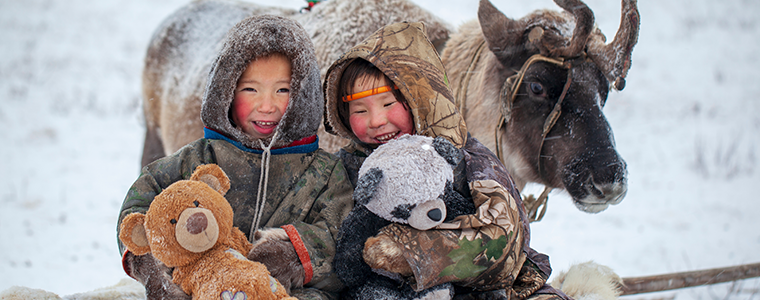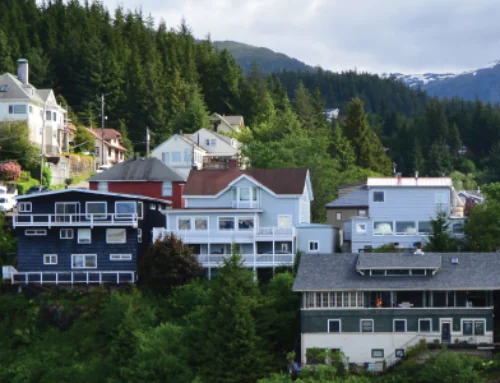What, exactly, is life like in Alaska? In the Last Frontier, you’ll find an extraordinary mix of natural beauty, culture, food, lifestyle, and traditions that you won’t find anywhere else in the world.
To give you an insider’s look at Alaska, we’ll focus in on the most fascinating traditions you’ll encounter in the state. Many of them come from the indigenous settlers of the area, the Alaska Natives. Other traditions have evolved through the practices and rituals of later arrivals to the state.
All of them will give you a sense for what it’s really like to live in the Last Frontier.

The Traditions of Alaska’s Native Peoples
15.7%
population that identifies as American Indian or Alaska Native
According to census data, 15.7% of Alaska’s population currently identifies as American Indian or Alaska Native. Only 1.3% of the overall U.S. population identifies as such, so you can see just how strongly the culture of Alaska’s Native peoples permeates the state.
Alaska Natives identify with several distinct nations and tribes. The Alaska Federation of Natives (AFN) identifies eleven cultures within Alaska:
- Eyak, Tlingit, Haida, Tsimshian peoples in the southeast
- The Iñupiat and St. Lawrence Island Yupik in the north and northwest
- Yup’ik and Cup’ik Alaska Natives in the southwest
- The Athabascan peoples in Alaska’s interior
- The Alutiiq (Sugpiaq) and Unangax̂ peoples in southcentral Alaska and the Aleutian Islands
Each of these different cultures has their own traditions. Below, we’ll explore some traditions shared by multiple groups, as well as ones identified with specific cultures.
Ultimately, we’re only able to scratch the surface in this article. If you live in Alaska, you’ll get the chance to explore the traditions of the Alaska Native peoples first-hand. If you’re new to Alaska, the Alaska Native Heritage Center in Anchorage and the Sealaska Heritage Museum in Juneau are both great places to start.
Potlatch Ceremonies
In Chinook, potlatch means “to give.” Traditionally, Athabascan, Tlingit, and Aleut peoples held ceremonial gatherings called potlatches. Although the specifics of the celebrations—and the occasions that warranted a potlatch—differed from village to village, the overall idea of a potlatch was to commemorate a meaningful event, such as a death.
Potlatches generally involved hosting visitors from other villages and treating them to lavish food and entertainment, including singing, dancing, and other performances. Gift-giving was often a key element, as well.
The Government of Canada banned potlatches from 1885 until 1951, and the U.S. enacted similar laws. The ban was repealed in 1934 in the U.S. Since then, the tradition has slowly been revived by many tribes and villages.
Although they may not call them “potlatches,” other Alaska Native peoples have their own ceremonial rituals that involve feasting and gift-giving.
Potlatch = Potluck?
Because potlatches involve sharing food, many people wonder whether the traditional potlatch might be related to our modern word for a party with shared food—the potluck.
As we mentioned above, potlatch is a word that comes from Chinook. The word potluck originated in England in the 16th century. It comes from the idea that an unexpected visitor might get what was left of a previous meal and enjoy “the luck of the pot.”
In other words, although potlatches and potlucks both embrace the idea of shared food, they don’t share a common etymological origin.

Carving Traditions
You’ll find different types of carving traditions all over Alaska. The Eyak, Tlingit, Haida, and Tsimshian peoples are known for their intricate totem poles. You’ll also find smaller-scale carvings made by Iñupiaq, Yup’ik, and Cup’ik peoples. Some of these carvings are made out of bones or tusks, while others are done from wood and soapstone.
You’ll also find hand-carved dance masks in Alaska, used in ceremonial rituals. Masks are made by a number of different Native peoples, and they incorporate a variety of natural materials, including wood, bone, feathers, rocks, and shells.
If you’re shopping for pieces to invest in while you’re in Alaska, keep your eyes out for the Silver Hand emblem.
Look for the Silver Hand
The seal indicates that the piece was created by hand in Alaska by an Alaska Native artist. The Silver Hand program helps Alaska Native artists promote their work and ensures you’re buying only Alaska Native art.

Weaving Traditions
Around Alaska, you’ll find various types of weaving arts in practice, used to create both functional items as well as decorative ones. Unangax̂, Sugpiaq, Tsimshian, and Yup’ik peoples are known for their woven baskets, some done artfully enough to hold water. Other cultures, like the Tlingit, wove items that would be worn at ceremonies or festivals.
All of these woven items used natural materials easily available to the people who created them, including rye grass, birch bark, willow root, cedar bark, and mountain goat wool.
To get a deeper look at this art form, check out this video from the Smithsonian Arctic Studies Center featuring Annette Island Tsimshian Basket Weaving:
Subsistence Hunting, Fishing, and Gathering
For a number of people, “living off the land in Alaska” is a dream sustained by reality shows like Alaska: The Last Frontier. For Alaska’s Native peoples, it’s a way of life that’s sustained generation after generation.
Native elders in Alaska continue to teach young people the traditional methods of hunting, fishing, and gathering all of their food, which have long been a way of life for Alaska Native peoples. In partnership with the U.S. Fish and Wildlife Service, lands and resources have been set aside to allow Alaska’s Native peoples to continue their subsistence traditions for generations to come.
Traditional Foods
Many aspects of the traditional diet of Alaska Natives are practical. Take, for example, akutaq. A Yup’ik word for “to stir,” akutaq was called “Eskimo ice cream” by later arrivals. The concoction generally consists of animal fat (from caribou, bear, or muskox), animal oil (from a seal or whale), and some kind of flavoring, all whipped up into a frothy treat—and a vital form of nutrition.
Akutaq was a necessity that kept Alaskan hunters going while they were out on long hunting trips. High in fat and protein—and perfectly preserved in cold temperatures—akutaq was the ultimate excursion food.
Muktuk, sliced strips of whale skin and blubber, offers a similarly high-fat, high-protein food that offers nourishing sustenance.
Today, these foods are still prepared and consumed by Alaska Natives. If you’re lucky enough to be offered a taste, don’t hesitate to give them a try!
Next, we’ll take a look at a tradition in Alaska that Alaska Natives and Alaska residents share with the rest of the world.

Storytelling Traditions in Alaska
Storytelling is a human tradition. Naturally, you’ll find that Alaska has its own myths, stories, and legends, many of which come from Alaska Native traditions. Like many other indigenous cultures, Alaska Native peoples maintain a rich storytelling tradition. These shared stories conveyed important information through the generations, including customs, wisdom, origin stories, history, and important lessons.
Many stories you’ll hear in Alaska also share through-lines with other cultures around the world.
Take, for example, the stories surrounding the Hairy Man or the Alaska Bushman. This half-human creature roams the wilderness, uprooting trees and causing mysterious disappearances. Those raised in the U.S. might see a resemblance to the Bigfoot legends. The Inuit believe that these creatures descended from a people called the Tornit.
To get a taste of the stories you might hear in Alaska, check out our article: “Meet 10 Mythical (and Mysterious!) Creatures Who Live in Alaska.”

Solstice Celebrations in Alaska
Celebrating the solstice takes on new meaning in the Land of the Midnight Sun. You’ll find summer solstice celebrations all over the state, especially in Anchorage, which receives 22 hours of functional daylight on the summer solstice. Hiking Flattop Mountain on the solstice is a time-honored tradition in Anchorage. You’ll also find celebrations downtown, as well as the Slam’n Salm’n Derby competition to reel in the biggest king salmon.
Even though the winter solstice represents the darkest day of the year, plenty of Alaska residents find ways to mark the day. Fairbanks celebrates with fireworks, which shine bright in winter’s darkest sky. Other Alaska residents build bonfires to chase away the cold and herald the return of the sun.

PFD Day / Dividend Day in Alaska
You might think the happiest day in Alaska would be the summer solstice. However, that honor likely goes to Dividend Day (or “PFD Day,” as it’s also known)—the day that Alaska residents receive their Permanent Fund Dividend (PFD) check.
As you may know, the Alaska Permanent Fund was designed to convert the state’s oil and mineral resources into a renewable financial resource for future generations. Every year, eligible Alaska residents receive a payout from this fund, which has historically ranged from $386.15 to $3,284.00.
Every Alaska resident spends Dividend Day a little differently. However, local retailers often see a bit of a boom that day as residents head out to spend some (or all!) of their PFD check.
72%
Alaska residents who spend their PFD check on essentials
Curious how most Alaska residents spend their PFD checks? 72% reported saving it for essentials, emergencies, education, or retirement. Those who did spend it put it toward paying off their bills. Other Alaska residents report using their checks to pay a deposit toward their winter fuel bills.
However you decide to spend your dividend, a celebratory PFD Day is a time-honored tradition in Alaska.

Alaska’s Busy Festival Calendar: A Time-Honored Tradition
Finally, Alaska residents love a good excuse to gather together and enjoy some fun. You’ll find festivals year-round in Alaska, and they’re all great way to celebrate the things that make Alaska special.
Some of our favorite Alaska festivals and celebrations include:

Celebrating Alaska’s Unique Traditions and Rituals
The traditions of the people you’ll meet in Alaska are as unique as the place itself, and they lend yet another layer to the fascinating natural and cultural landscape of the state. You’ll find variations of these practices around the globe, but Alaska offers its own take on each—all of which are worth experiencing for yourself.
Considering a move to Alaska so you can enjoy these traditions in person? Our team would be happy to help! We’ve helped individuals and families move to locations all over the state. To get started, request a free quote from one of our experts.
Tell us about your move!
 (907) 868-4756
(907) 868-4756


